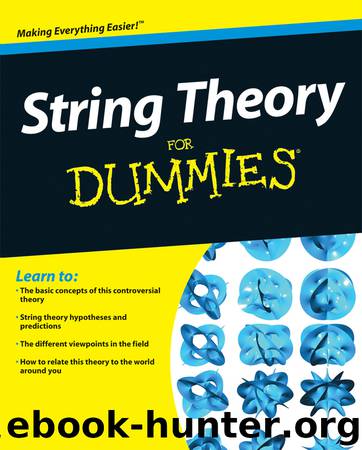String Theory for Dummies by Jones Andrew Zimmerman

Author:Jones, Andrew Zimmerman
Language: eng
Format: epub
Publisher: John Wiley & Sons, Inc.
Published: 2010-03-08T16:00:00+00:00
String theory demands that these closed strings must exist, though open strings may or may not exist. Some versions of string theory are perfectly mathematically consistent but contain only the closed strings. No theory contains only open strings, because if you have open strings, you can construct a situation where the ends of the strings meet each other and, voilà, a closed string exists. (Cutting closed strings to get open strings isn’t always allowed.)
From a theoretical standpoint, this was astounding (in a good way). Instead of trying to shoehorn gravity into the theory, the graviton fell out as a natural consequence. If superstring theory was the fundamental law of nature, then it required the existence of gravity in a way that no other proposed theory had ever done!
Immediately, it became clear to Schwarz and Scherk that they had a potential candidate for quantum gravity on their hands.
Even while everyone else was fleeing from the multiple dimensions their theory predicted, Scherk and Schwarz became more convinced than ever that they were on the right track.
The other supersymmetric gravity theory: Supergravity
Supergravity is the name for theories that attempt to apply supersymmetry directly to the theory of gravity without the use of string theory. Throughout the late 1970s, this work proceeded at a faster pace than string theory, mainly because it was popular while the string theory camp had become a ghost town. Supergravity theories prove important in the later development of M-theory, which I cover in Chapter 11.
In 1976, Daniel Freedman, Sergio Ferrara, and Peter van Nieuwenhuizen applied supersymmetry to Einstein’s theory of gravity, resulting in a theory of supergravity. They did this by introducing the superpartner of the graviton, the gravitino, into the theory of general relativity.
Building on this work, Eugene Cremmer, Joel Scherk, and Bernard Julia were able to show in 1978 that supergravity could be written, in its most general form, as an 11-dimensional theory. Supergravity theories with more than 11 dimensions fell apart.
Supergravity ultimately fell prey to the mathematical inconsistencies that plagued most quantum gravity theories (it worked fine as a classical theory, so long as you kept it away from the quantum realm), leaving room for superstring theory to rise again in the mid-1980s, but it didn’t go away completely. I return to the idea of the 11-dimensional supergravity theory in Chapter 11.
String theorists don’t get no respect
During the late 1970s, string theorists were finding it hard to be taken seriously, let alone find secure academic work. String theorists’ search for respect in the field of physics reminds me of a young Einstein working in the Bern patent office, denied job after job while he thought about mass and energy.
There had been earlier issues in getting recognition for string theory work. The journal Physics Review Letters didn’t consider Susskind’s 1970 work — interpreting the dual resonance model as vibrating strings — significant enough to publish. Susskind himself tells how physics giant Murray Gell-Mann laughed at him for mentioning string theory in 1970. (The story ends well, with Gell-Mann expressing interest in the theory in 1972.
Download
This site does not store any files on its server. We only index and link to content provided by other sites. Please contact the content providers to delete copyright contents if any and email us, we'll remove relevant links or contents immediately.
The Complete Stick Figure Physics Tutorials by Allen Sarah(7339)
Secrets of Antigravity Propulsion: Tesla, UFOs, and Classified Aerospace Technology by Ph.D. Paul A. Laviolette(5336)
Thing Explainer by Randall Munroe(3911)
The River of Consciousness by Oliver Sacks(3574)
The Order of Time by Carlo Rovelli(3164)
How To by Randall Munroe(3078)
A Brief History of Time by Stephen Hawking(2994)
I Live in the Future & Here's How It Works by Nick Bilton(2963)
What If?: Serious Scientific Answers to Absurd Hypothetical Questions by Randall Munroe(2670)
The Great Unknown by Marcus du Sautoy(2664)
Midnight in Chernobyl by Adam Higginbotham(2519)
Blockchain: Ultimate Step By Step Guide To Understanding Blockchain Technology, Bitcoin Creation, and the future of Money (Novice to Expert) by Keizer Söze(2467)
Networks: An Introduction by Newman Mark(2383)
The Meaning of it All by Richard Feynman(2320)
Easy Electronics by Charles Platt(2310)
The Tao of Physics by Fritjof Capra(2247)
Midnight in Chernobyl: The Untold Story of the World's Greatest Nuclear Disaster by Adam Higginbotham(2200)
Introducing Relativity by Bruce Bassett(2098)
When by Daniel H Pink(2098)
